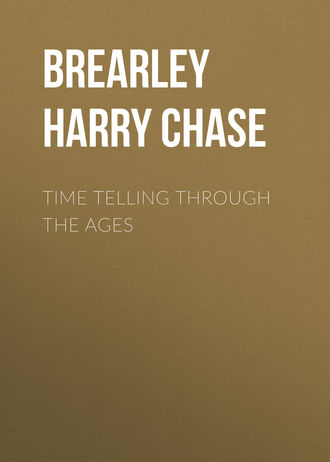 полная версия
полная версияTime Telling through the Ages
Escapement, Lever – Club Tooth – An escapement like the Table Roller in the action of the lever and roller, but differs in the pallet action. The impulse planes are partly on the teeth and partly on the pallet. This is the standard watch escapement of today.
Escapement, Crank Lever – An escapement with a small roller having a tooth like a pinion leaf projecting from its circumference. This tooth acts in a square notch cut in the end of the lever. The lever is formed like a fork the two points of which act as safety pins against the edge of the roller to prevent the lever from getting out of action with the roller. It necessitated very careful construction and was not so good as the Double Roller or Table Roller.
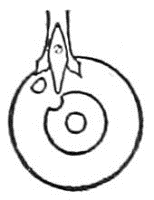
Escapement, Lever – Double Roller – This escapement has two rollers on the balance staff, the large one carrying the balance staff and the small one used for a safety roller only. The best form of lever escapement but more delicate, expensive, and difficult to make than the Table Roller; hence not so much used as the latter.
Escapement, Patent Detached Lever – Introduced in 1766 by Thomas Mudge, but neglected for years thereafter even by Mudge himself. It was in some of its parts the model of the best form of lever escapement – the Double Roller. The first pallets had no "draw" on the locking faces which rendered the escapement peculiarly sensitive to jolt and jar. This may have suggested to Mudge the addition of the small roller, whose worth has been since unquestionably demonstrated.
Escapement, Lever – Pin-Pallet – A lever escapement with round pins for pallets, and the inclines on the escape teeth. Used in alarm clocks.
Escapement, Rack-Lever – Invented by Abbe Hautefeuille in 1734. Afterward made and improved by Berthoud and by Peter Litherland, who obtained a patent for it in 1794. It consisted of anchor shaped pallets on whose axis was fixed a rack, or segment of a toothed wheel which geared into a pinion on the axis of the balance. The balance was thus never free from the train and good timekeeping was made impossible. It is not now in use.
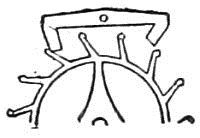
Escapement, Lever-Resilient – Invented by F. J. Cole about 1870. A form of lever escapement designed to obviate the evils of overbanking. The points of the escape-wheel teeth are bent toward the locking faces of the pallets, the bend in the tooth acts as the banking and no pins are required. It was abandoned because expensive to make and the danger of overbanking is not considerable.
Escapement, Lever – Table Roller – Excellent and very simple and the most common form today. It differs from the crank lever only in the action of the roller. The impulse pin instead of projecting beyond the edge of the roller is set within its circumference and raised above its plane.
Escapement, Lever – Two Pin – A form of Lever Escapement in which the unlocking and impulse actions were formerly divided between two small gold pins in the roller and one in the lever. Later the two roller pins were discarded, and one broad jewel pin substituted.
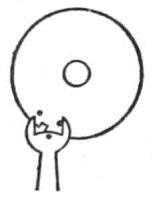
Escapement – Pin Wheel – Invented by Lepaute about 1750. Similar in action to the dead-beat. A good and simple escapement for large clocks. The impulse is given the pendulum through the pallets by pins which stand out from the face of the escape wheel. Lepaute made these pins semi-circular and had his pallets of equal length acting on opposite sides of the wheel. Sir E. Beckett cut away part of the front of the pins which allows the pallets to act as in the diagram. The resting faces are arcs of a circle. It has been superseded by the gravity escapement for large clocks and is inferior to the dead-beat for small.
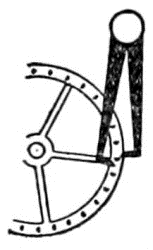
Escapement, Recoil – Any escapement in which the pallets actually force the escape wheel to turn backwards a trifle with each beat of the balance. Cheap and easy to make but inferior as timekeepers to the detached or dead-beat types.
Escapement, Right-Angled – A lever escapement so set that lines drawn between the centers of the balance, pallets, and escape wheel would form a right angle. See Escapement, straight-line.
Escapement, Single-Beat – An escapement such as the Duplex, or Chronometer, whose escape wheel moves only at alternate beats of the balance or pendulum.
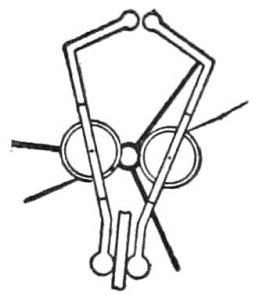
Escapement, Single Three-Legged Gravity – Consists of two pallets and one three-legged locking wheel. Instead of the three pins for lifting as in the Double Three-Legged Gravity escapement there is a triangular steel block which acts against large friction rollers, pivoted one on each pallet.
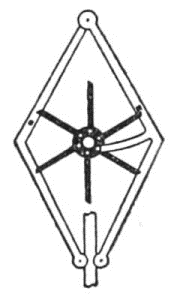
Escapement, Six-Legged Gravity – A modification of the three-legged gravity escapement. The locking wheel has six teeth. One of the pallet arms is neutral and gives no impulse, hence impulse is given only at each alternate vibration. A much lighter driving weight than for the Double Three-legged Gravity escapement will suffice for this, since the rotations of the escape wheel required are only half as many.
Escapement, Straight-Line – An escapement of the lever type in which the escape wheel, pallets and balance are all in a straight line; an arrangement favored by the Swiss.
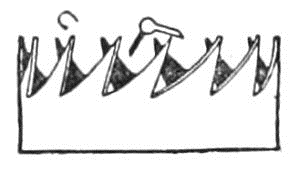
Escapement, Verge – Also called "Crown-wheel," or Vertical escapement. The earliest form of escapement on record. The inventor is not known, but the escapement was used on de Vick's clock. (1364.) It was used almost exclusively up to 1750 in spite of its manifest inaccuracy. The verge is a frictional recoil escapement. It consists of a crown-wheel, with eleven, thirteen, or fifteen teeth, shaped like those of a rip saw, and with its axis set at right angles to the pallets axis, or verge, which carries the balance. The verge is a slender cylinder as small as compatible with the required strength, from which project the pallets, two flat steel "flags" – at an angle to each other varying from 90° to 115°. The wheel runs in a watch in a plane at right angles to the face. Any variation in the motive power causes a variation in the arc of the balance swing. Therefore, since the time of oscillation depends on the arc of the swing, the time-keeping qualities were directly affected. This gave rise to the invention of the stack-freed and fusee, both contrivances to equalize the power of the mainspring. In spite of the many defects the verge escapement was one of the great inventions because the first escapement, and was used for centuries before superior kinds were devised. It necessitated thick and bulky watches.
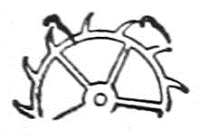
Escapement, Virgule – An early form of escapement invented about 1660 by Abbe Hautefeuille. Its action can be readily understood from the diagram.
Escape Pinion – The pinion on the escape-wheel arbor.
Escape Wheel – The last wheel of a train: it gives impulse to the balance, indirectly. Also called scape wheel. Easily identified by teeth resembling those of a circular saw.
Face – 1. Of a watch or clock is the dial. 2. Of the tooth of a wheel, that portion beyond the pitch line.
Facio, Nicolas – A Geneva watchmaker who invented the art of piercing jewels for use in watches, and in May, 1705, obtained a patent therefor in London. In December of the same year when he petitioned for a more extended patent he was opposed by the Clockmakers' Company, who produced in evidence proof that Facio was not first in this use of jewels, in an old watch of Ignatius Huggeford's with an amethyst mounted on the cock of the balance wheel. Facio's petition was denied. It was later discovered that Huggeford's jewel had nothing to do with the mechanism of the watch.
Favre, Perret E. – In 1876 the chief commissioner in the Swiss Department and a member at that time of the International Jury on Watches at the Centennial Exhibition at Philadelphia. On his return home he was very emphatic in his endorsement of the American method of manufacture as compared to the Swiss.
Fitch E. C. – Made president of the Waltham Watch Co., in 1886. His long experience in watch case and movement making and his commercial training made his judgment on matters relating to watchmaking of value. He was the inventor of the screw bezel case.
Flank – The flank of a wheel or pinion is the part lying between the pitch circle and the center.
Flirt – Any device for causing the sudden movement of a mechanism.
Fly – A speed regulating device or governor consisting of a fan or two vanes upon a rotating shaft. Used in the striking part of clocks. By some believed to have been used on the earliest clocks – before the verge escapement – to check a too rapid descent of the weight.
Fly Pinion – The pinion in a clock that carries the fly: a part of the striking mechanism.
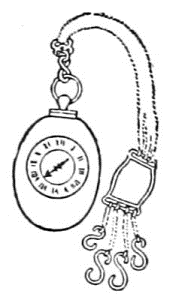
Fob – Properly a watch pocket in the waistband of trousers. Commonly applied to the end of a chain or ribbon which is attached to the watch and hangs free from the pocket. One of the early examples was attached to a watch made for Oliver Cromwell in 1625 by John Midwall in Fleet Street.
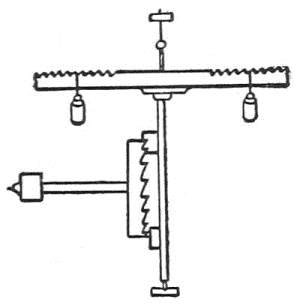
Foliot – A straight armed balance with weights used as one of the earliest clock regulators. De Vick's clock is one example of it.
Foliot Balance – See Foliot.
Follower – Of two wheels geared together, the one to which the driver imparts motion is called the follower.
Fork – The fork shaped end of the lever into which plays the roller jewel.
Fourth Wheel – The wheel in a watch that drives the escape pinion and to whose arbor the seconds hand is attached.
Frame – The plates or plate and bars of a watch or clock which support the pivots of the train.
Free Spring – A balance spring not controlled by curb pins. Used in chronometers and other fine time pieces where the spring is an overcoil.
Fromanteel, Ahasuerus – A clockmaker of Dutch extraction – maker of steeple clocks in East Smithfield. The family of Fromanteels were celebrated as having been the first to introduce the pendulum clocks into England. Their claim has since been contested in favor of Harris and Hooke.
Full Plate – A model in which the top plate is circular in form – the balance being above this plate. Used now in 18 size watches for railroad and other hard usage. They are made only in limited quantities.
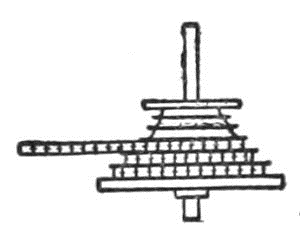
Fusee – Invented by Jacob Zech of Prague about 1525. Consists of a specially grooved cone-shaped pulley interposed between the mainspring barrel and the great or driving wheel of a watch or clock. The connection between the barrel and fusee was first made by a cord or catgut, later by a chain. In winding the spring the cord is drawn from the barrel on to the fusee – the first coil on the larger end. Thus the mainspring when fully wound uncoils the cord first from the smaller end of the fusee; and as it runs down gets the benefit of increased leverage by reason of the greater diameter of the lower part of the fusee. An excellent adjustment of the pressure on the center pinion can be made in this way. The fusee has been abandoned in watches to allow of thinness, but is still used in chronometers and clocks.
Fusee Cap – A thin steel plate with a projecting nose on the smaller end of the fusee: a part of the mechanism to stop the fusee when the last coil of the chain is wound thereon.
Fusee Chain – A very delicate steel chain connecting the barrel with the fusee of a watch, chronometer or clock. It replaced the catgut originally used and was first introduced by Gruet of Geneva about 1664.
Fusee Sink – The sink cut in the top plate of a watch to give space for the fusee.
Galileo, Galilei – Commonly called "Galileo." A famous Italian scientist born in 1564 who discovered, among many other things, the isochronism of the pendulum vibrating through long or short arcs. The story goes that he noticed that a swinging chandelier in a certain cathedral took the same length of time to each vibration whether in long or short arcs – timing them by his pulse. He seems never to have applied this principle to clocks, although he issued an essay on the subject in 1639.
Galileo, Vincentis – Son of the great astronomer, born about 1600. He aided his father in experiments and gave special attention to the application of the pendulum to clocks. He is claimed by some to have been the first to so apply the pendulum, in 1649, but this is disputed in favor of Richard Harris of London.
Geneva – A city in Switzerland in which watchmaking was first established in that country. It is the center of the "hand" industry, and the city is honeycombed with garret-workers – so-called – making parts.
Gerbert (Pope Sylvester II) – Born in Belliac, Auvergne, in 920. In 990 Gerbert made some sort of a clock which attained wide fame. Some authorities claim that it was a clock moved by weights and wheels and some even claim for it a verge escapement. On the other hand, other authorities state positively that that story is a myth and that Gerbert's horologe was a sun-dial. It seems pretty well accepted that there was no escapement used, however, until more than two centuries after Gerbert's time.
German Silver – An alloy of copper, nickel, and zinc – copper predominating. Really a white brass.
Gimbal – A contrivance resembling a universal joint permitting a suspended object to tip freely in all directions. Marine chronometers are supported in their cases or boxes by gimbals. It was first applied to chronometers by Huyghens.
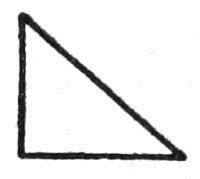
Gnomon – A simple and probably the most ancient instrument for marking time consisting simply of a staff or pillow fixed perpendicularly in a sunny place – time being reckoned by the changing length of the shadow or by its angular movement. In more recent times the title "gnomon" was applied to the style of the sun-dial.
Gnomonics – The art of constructing and setting sun-dials taught especially in the seventeenth century.
Goddard, Luther – Born at Shrewsbury, Mass., February 28, 1762 – Died 1842. He was the first American to manufacture watches. He began in 1809 but unable to compete as to price with cheap foreign watches, retired after making about five hundred.
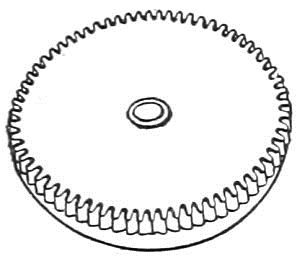
Going-Barrel – The Swiss early abandoned the fusee in watches and cut teeth around the outside of the main-spring barrel so as to drive the train direct. Such an arrangement is called a going-barrel. It made possible a thinner and much simpler watch. American makers quickly adopted this device, but the English long clung to the fusee. It is sometimes claimed that the French were the first to adopt the going-barrel.
Going Fusee – A fusee with maintaining power attachment, so that the watch does not stop while being wound. Invented by Harrison.
Golden Number – Meton, an Athenian astronomer, discovered about 432 B. C. that every nineteen years the new and full moons returned on the same days of the month. This period is the cycle of the moon, called the Golden Number because the Greeks, to honor it, had it written in letters of gold. Anno Domini, the year of our Lord, fell on the second year of a lunar cycle. Hence, to find the Golden Number for any year, add 1 to the date (A. D.) and divide by 19. The remainder is the Golden Number for the year.
Gold-Filled – A sheet of brass sandwiched between two thin plates of gold and all brazed together. Gold-filled watch cases were introduced in America. They give very good wear.
Graham, George, F. R. S. – An English watchmaker and astronomer, born in Cumberland in 1675. Died 1751. He was an apprentice of Tompion and succeeded to Tompion's reputation as the best watchmaker of his time. He invented the mercurial compensation pendulum, the dead-beat escapement, and perfected the cylinder escapement of Tompion and left it in practically its present form. He made ornamentation distinctly subsidiary to use. He was master of the Clockmakers' Company in 1722-23. He was buried with Tompion in Westminster Abbey.
Great Tom – The great bell which struck the hours on the first clock at Westminster. It was afterwards transferred to St. Paul's.
Great Wheel – In a fusee watch the toothed wheel which transmits the power from the fusee to the center pinion. In a going-barrel watch it is represented by the toothed portion of the barrel drum.
Greenwich Observatory – (England) Royal observatory founded 1675 to promote astronomy and navigation. There is at this observatory a standard motor clock which is the center of a system of electrically controlled clocks scattered over the Kingdom, and which thus keeps official time as our Naval Observatory clock does for the United States.
Grimthorpe – See Denison, E. B.
Gruen, Dietrich – A Swiss watchmaker who with his son Fred first succeeded in making a very thin watch. The Gruen watch factory at Cincinnati, Ohio, is unique in this country. The buildings and surroundings resemble those of Switzerland, and the method of manufacture embodies more handwork than is common in the American system.
Gruet – A Swiss who introduced chains for the fusee instead of catgut cord, in 1664. They are still used for marine chronometers, some clocks, and the few fusee watches now made.
Guard Pin – A pin in a lever escapement which prevents the pallets leaving the escape wheel when the hands of a watch are turned back. Also known as the "safety pin."
Guild or Gild – An association of people occupied in kindred pursuits for mutual protection and aid. Watch and clockmakers belonged to the Blacksmiths' Guild in England until 1631, when the Clockmakers' Company was formed. In France the Clockmakers' Guild was powerful in 1544.
Hair-Spring – Said by some to be a distinctly American term for the balance spring of a watch. But Wood (English) uses it in his "Curiosities of Clocks and Watches," 1866. However, it is not in common use outside of America. It is thought to have originated from the fact that in early times attempts were made to utilize hog-bristle for the balance spring.
Half Plate – A watch in which the top plate covers but half of the pillar plate, the fourth wheel pinion being carried in a cock to allow the use of a larger balance. Now obsolete or nearly so. Replaced by the bridge-model.
Hall Mark – A stamp placed upon gold and silver articles by government officials after the metal therein has been assayed.
Hands – The metal pointers which, moved by the train, indicate the time by pointing to the figures on the dial. At present there are always two, the hour and minute hands and frequently a seconds hand also. Clocks at first were made with only the hour hand; the minute hand was introduced when the use of the pendulum made timekeeping sufficiently accurate for the indication of such small divisions.
Hanging Barrel – A going-barrel with its arbor supported only at the upper end.
Harris, Richard – An English clockmaker for whom it is claimed that he made the first pendulum clock – set up at St. Paul's, Covent Garden, in 1641. Most authorities agree, however, that this honor belongs to Huyghens.
Harrison, John – An English mechanician born at Faulby in Yorkshire in 1693. He made many improvements in the mechanism of clocks, the greatest of which was the compound pendulum. He won in 1761 a reward offered by Parliament in 1714 for an instrument that would determine longitude within thirty marine miles. Harrison's chronometer gave it within eighteen miles. He invented the going fusee, the gridiron compensation pendulum and suggested the idea for the compensation balance, afterward worked out by other watchmakers. Died 1776.
Hautefeuille, John – (Abbe.) Born 1647. Died 1724. He disputed successfully Huyghens' claim to a prior invention of the steel balance spring. He is also credited with the invention about 1722 of the rack-lever escapement.
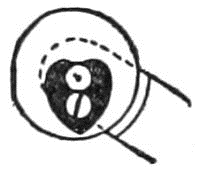
Heart-Piece – The heart-shaped cam on the center-seconds wheel of a chronograph, which causes the hand to fly back to zero.
Hele, Peter – (See Henlein, Peter.) Some historians credit invention of first watch to Peter Hele. There is no doubt, however, that Hele and Henlein were one and the same. Preponderance of authority favors "Henlein" as the correct spelling of the name.
Helical – Following the course of a helix or spiral.
Heliotropion – See "Polos."
Hemicycle – Form of sun-dial in which the shadow of a vertical pointer or "gnomon" is cast upon and moves around the inner surface of a half globe or sphere. Supposed to have been invented about 350 B. C. (See Sun-Dial). Vitruvius, the Roman Engineer, ascribes invention to the Babylonian priest and astronomer, Berosus.
Henlein, Peter – Sometimes called Peter Hele. A clockmaker of Nuremberg, who is believed to have made the first portable (pocket) clock or watch sometime early in the sixteenth century. Born 1480. Died about 1540. His clock was round, driven by a spring and had small wheels of steel. It was much larger than present day watches.
Hollow Pinion – A pinion bored through the center. The center pinion in many watches is hollow.
"Hon-Woo-Et-Low" or Copper Jars Dropping Water – A form of clepsydra at Canton, China, said to be between 3000 and 4000 years old. It consists of four copper jars arranged on steps. Each jar drops water into the one below it until the last one, in which a bamboo float, indicates the time in a rude way.
Hooke, Robert, M. D. – An English physician-philosopher born on the Isle of Wight in 1635. His accomplishments were numerous. He claimed to have discovered the isochronism of the balance spring and its application to watches, though this was also claimed by Huyghens. He invented a pendulum timekeeper for finding the longitude at sea; devised the first wheel-cutting engine about 1670; and he invented the anchor escapement for clocks. His studies and inventions covered a wide field. He died in 1702.
Horologe, (Orologe), (Horologium) – A general term applied indiscriminately in old writings to any mechanism for measuring time.
Horological Institute – British – An association of watchmakers founded in 1858 for the purpose of advancing the horological arts.
Horological Periodicals, American – American Jeweler, (Monthly), Chicago, Ill.; Goldsmith and Silversmith, (Monthly), New Haven, Conn.; Jeweler's Circular, (Weekly), New York,; Keystone (Monthly), Philadelphia, Pa.; Manufacturing Jeweler, Providence, R. I.; Mid-Continent Jeweler, Kansas City, Mo.; National Jeweler, (Monthly), Chicago, Ill.; Northwestern Jeweler, St. Paul, Minn.; Pacific Goldsmith, (Monthly), San Francisco, Cal.; Trader and Canadian Jeweler, Toronto, Canada.
Horologium – See Horologe.
Horology-The science of time-measurement or of the construction of time pieces.
Hour – Now consisting of sixty minutes or one twenty-fourth of an equinoctial day. Formerly one twelfth of the time between sunrise and sunset, and one twelfth of the time between sunset and sunrise; hence of different lengths for day and night in the different seasons. This required much adjustment of clocks; and automatic devices for such adjustment were in great demand. A standard hour of uniform length for all times and seasons was not adopted in Paris – the last place to change – until 1816.

